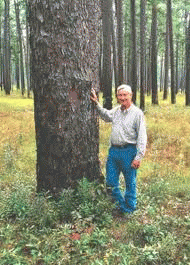| Back OpEd News | |||||||
|
Original Content at https://www.opednews.com/articles/Build-Your-Home-In-A-Healt-by-Ed-Komarek-Forest_Forest-Conservation_Forests_Forests-Burning-140603-279.html (Note: You can view every article as one long page if you sign up as an Advocate Member, or higher). |
|||||||
June 3, 2014
Build Your Home In A Healthy Wildfire-Safe Forest
By Ed Komarek
Build your home in a healthy fire-safe ecosystem not one where light fires have been suppressed creating an extreme fire hazard. Or if you do build in a unhealthy forest, or grassland, make sure you remove all hazards close to your house and then get the forest around your house back into a well fire-managed ecosystem.
::::::::
When the Europeans explorers left Europe and traveled to other lands during the voyages of discovery they found open, park-like forests and grasslands. What many of these Europeans did not realize was that these old-growth forests, clear of underbrush, and with trees spread apart enough to let light through the canopy, were being intensively managed by native peoples for their livelihood using periodic fire.
After these native peoples died, were killed, or driven from their lands, the build-up of debris and undergrowth from lack of cool cleansing fires soon created a catastrophic fire hazard in forests and savannas. By the late 1800s huge catastrophic wildfires caused by the lack of good fire management and over-logging, began to not only consume the old-growth forests, but man's cities as well.
In the United States and elsewhere around the globe, a powerful well-funded fire-suppression culture developed that continues to this day. In the United States the icon of this culture was the United States Forest Service's Smokey the Bear, part of a propaganda operation, a 120-year-old assault on public consciousness based on fear with no scientific basis. A general policy of fire exclusion by public land-management agencies has turned into an unmitigated disaster, both for light-fire ecosystems and for man, as homes, forests, and grasslands are devastated by catastrophic fire.
So what does a healthy fire-climax forest look like? In the Southeastern United States for example, there ares about 100 acres of old-growth Longleaf Pine Wiregrass left that was once part of Greenwood Plantation that my father managed for John H. Whitney. It's now being burned on a periodic basis by the Nature Conservancy. It's called the Big Woods and it regenerates naturally from small lightning kills that open up the canopy for new reproduction to grow. The book The Art of Managing Longleaf by Leon Neel, Paul Sutter, and Albert Way states:
"But neither of us was quite prepared to make to make sense of the unusual beauty of Greenwood. Yet that aesthetic reaction is the foundation of the Stoddard-Neel Approach. Many foresters are quick to dismiss aesthetics as a proper measure of good forestry, or they are uncomfortable with a set of values that seems not only far removed from the efficient production of timber, but sometimes even hostile to it.
"Leon Neel and Herb Stoddard before him, however, used the look of the woods as a gauge to measure their health. First, he instructed, a healthy longleaf woodland allows one to see a great distance through the trees but also always to see trees. As he makes clear in the memoir that follows, that long look through the forest, which early quail hunters in the region prized, is an important metric of several critical functional aspects of longleaf ecology and management.
"Second, Leon was quick to point to the many small patches, or "domes", of regeneration that dotted the understory. These are where the future of the forest, he insisted, as important as the gnarled flattops to his practice of forestry beyond one generation. When inspecting the woodlands he manages, Leon is quick to admire good, thick patches of regeneration in the small openings made by his careful forestry practice, and we have come to take joy in them too. Third, was the diversity of the understory as it existed across a landscape gradient defined by altitude and moisture.
"We stopped frequently to admire the seasonal blooms of orchids and other wildflowers and to note how the dry uplands gave way to thicker growth in the hardwood drains that ran through the Big Woods. While Leon insists that you can gauge the health of a Longleaf woodland by how it looks, he also has taught us that no two healthy longleaf woodlands look exactly alike. Indeed part of the aesthetic joy to be taken from these landscapes comes precisely in recognizing how geology, soils, micro-climates, moisture gradients, and disturbance histories sculpted them into a once-vast mosaic."
There is no way I can really explain all this in just one article, but in my new book now free on its website called Fire In Nature, A Fire Activist's Guide, I pull together what I know about the importance of fire in nature, learned as a young man mentored by the best ecologists and fire ecologists in the world at that time. This and other articles on OpEdNews or my blog can be republished by any media without my permission, as I try to reach as large an audience as is possible. Just try to include a link back to the book website if possible.
Authors Website: http://fireinnature.weebly.com/
Authors Bio:
Ed Komarek writes articles and books on diverse topics of national and international interest. The first book Ed wrote was UFOs Exopolitics and the New World Disorder that is available for free on its website. Ed's second book Fire In Nature, A Fire Activists Guide is also free on its website.
